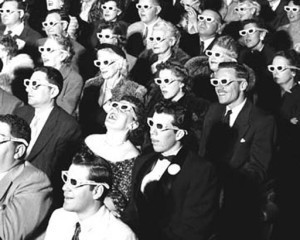Blog in Progress: Audience Awareness

By Lisa Borders
I’ve never had my own blog. I’ve also never kept a journal, or the kind of diary Marcia Brady famously lost. I’d sometimes receive them as gifts when I was a kid, those little diaries with leatherette covers and a tiny lock on the front; after a week, my entries would taper off. After a month, I was done.
And yet, I’m a big fan of recording the minutiae of daily life. I composed bad confessional poetry from the time I was seven years old until I was about twenty. After that, I wrote long letters to friends. In the early days of the internet, I found my way to message boards that I posted on regularly. And now, I spend enough time on Facebook that my friends tease me about it.
It was never the idea of journaling per se that I found distasteful; for me, the problem was the notion of audience. For whom, exactly, was I writing these journal entries? Myself at an older age? The historians who would surely want to read my personal diaries after I became a famous writer (ha, ha)?
When the question of launching my own blog came up as I prepared for the publication this fall of my second novel, The Fifty-First State, I wondered again: who is the intended audience of this blog? My interests are wide-ranging and not just related to writing. I could imagine having a blog about writing, one about music, perhaps another about animals and animal welfare issues. When I reached the point where I had enough blog ideas for days of the week, I knew things had gotten out of hand – at least, if I wanted to hold on to the income-generating jobs that keep a roof over my head.
So when the opportunity to write a monthly blog for Grub Street came up, I jumped at the chance. Finally, a clear audience: other writers! I’m calling it Blog in Progress, partly as an homage to the Novel in Progress classes I launched at Grub Street years ago, and partly because for me, blogging regularly is a work in progress. Each month, I will address a topic related to fiction writing, must-read books, or the publishing world.
Which brings me back to this month’s topic: the notion of audience. When I started writing and submitting my first short stories, I didn’t think at all about audience. I wrote what delighted me, and then I revised to make the stories and characters work. Somehow, this haphazard process landed my stories in a few literary journals, so apparently my work did target that audience.
Once I started writing novels, the stakes became higher. The structure of my first novel, Cloud Cuckoo Land, was loosely based on Willa Cather’s The Song of the Lark. The first part of Cloud Cuckoo Land was set in Texas and based on my narrator’s early life. The second part took place in Philadelphia, where she scrambled to find her footing as a musician. In Part III, she began to succeed in her chosen field as she overcame her difficult early years.
The problem with this structure was – you guessed it – audience. As I sent the manuscript to agents, I heard from some that if I rewrote the book and set it all in Texas, they’d consider taking me on as a client; others said the opposite, that they preferred the grittier sections set in Philly and wanted the whole book to take place there. I realized there was a tonal shift in Part II of the book, but I felt that Cather’s novel, a beloved favorite of mine, did the same thing. I decided to keep the book the way it was and start targeting small press contests. Eventually, I won one, and the book was published in 2002.
But it wasn’t until I had a long discussion with a generous editor at a large publishing house that the notion of audience – and my utter disregard for it in writing Cloud Cuckoo Land – really clicked for me. This editor had stumbled upon my book, fallen in love with it, and tried, unsuccessfully, to get her press to buy the paperback rights. When I had lunch with her, she explained to me that the problem had been marketing. The Texas sections, she said, had the kind of sass and sensibility associated with Southern Fiction. The Philadelphia sections, with their backdrop of the alternative rock scene of the 1980s, would appeal to rock fans and more urban readers. The novel seemed to target two entirely different audiences. As a reader, this editor herself hadn’t found the shift to be a problem; but from a marketing perspective, the book was seen as too great a challenge.
I was, of course, terribly disappointed by this news, and at first, I was even a little angry. Why couldn’t the audience for my novel simply be people who like to read? Were modern readers so unwilling to step outside their comfort zones that they couldn’t handle a book that went somewhere unexpected? Why had this been okay in Willa Cather’s day, but not now?
With time and distance, though, I have more sympathy for the perspective of the marketer. It’s always an uneasy relationship, this one between art and commerce; but unless we’re writing in private journals, only for ourselves, we writers must take audience into account. In Cather’s time, publishing houses did not have so many other forms of entertainment competing for the public’s attention, and as a result, authors could take more artistic liberties and still have a good shot at selling their novels. Today, more than ever, an author doesn’t have that luxury.
This doesn’t mean that a writer can’t get highly literary, or even ground-breaking, work published today. As both a writer and a reader, I’d hate to live in a world where that kind of fiction wasn’t available. But it will have a smaller audience, and writers need to know that when they make certain stylistic choices, they may be narrowing their audience. I always advise my students to make the best choices for the book itself, the ones necessary to tell the story; but to be aware, as those choices are made, of how they are affecting the potential audience.
So how does a writer with a manuscript in progress sort out this notion of audience? I’d say that unless one is writing in a genre where the audience is clearly defined – young adult, perhaps, or mystery – I wouldn’t put too much thought into audience until the revision process begins. The first draft stage is usually quite messy, at least for me; the writer may try, and fail, at a variety of plot twists, narrative voices, structures before completing something that seems to have a beginning, a middle and an end. It’s in the later drafts, as the writer commits to choices taking the book in a certain direction, that the notion of audience should start being considered.
I’d love to hear in the Comments section about whether, and at what point, you, dear writers, take audience into account. And I will keep my Grub students, as well as writers outside of Boston, in mind as I continue this Blog in Progress.
Tweet



